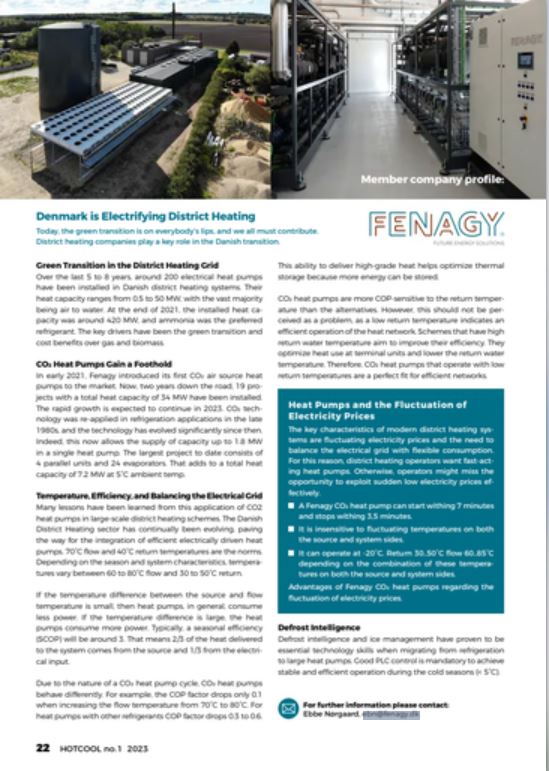Today, the green transition is on everybody’s lips, and we all must contribute. District heating companies play a key role in the Danish transition.
Green transition in the district heating grid
Over the last 5 to 8 years, around 200 electrical heat pumps have been installed in Danish district heating systems. Their heat capacity ranges from 0.5 to 50 MW, with the vast majority being air to water. At the end of 2021, the installed heat capacity was around 420 MW, and ammonia was the preferred refrigerant. The key drivers have been the green transition and cost benefits over gas and biomass.
CO2 heat pumps gain a foothold
In early 2021, Fenagy introduced its first CO2 air source heat pumps to the market. Now, two years down the road, 19 projects with a total heat capacity of 34 MW have been installed. The rapid growth is expected to continue in 2023. CO2 technology was re-applied in refrigeration applications in the late 1980s, and the technology has evolved significantly since then.
Indeed, this now allows the supply of capacity up to 1.8 MW in a single heat pump. The largest project to date consists of 4 parallel units and 24 evaporators. That adds to a total heat capacity of 7.2 MW at 5°C ambient temp.
Temperature, efficiency, and balancing the electrical grid
Many lessons have been learned from this application of CO2 heat pumps in large-scale district heating schemes. The Danish District Heating sector has continually been evolving, paving the way for the integration of efficient electrically driven heat pumps. 70°C flow and 40°C return temperatures are the norms. Depending on the season and system characteristics, temperatures vary between 60 to 80°C flow and 30 to 50°C return.
If the temperature difference between the source and flow temperature is small, then heat pumps, in general, consumeless power. If the temperature difference is large, the heat pumps consume more power. Typically, a seasonal efficiency (SCOP) will be around 3. That means 2/3 of the heat delivered to the system comes from the source and 1/3 from the electrical input.
Due to the nature of a CO2 heat pump cycle, CO2 heat pumps behave differently. For example, the COP factor drops only 0.1 when increasing the flow temperature from 70°C to 80°C. For heat pumps with other refrigerants COP factor drops 0.3 to 0.6.
This ability to deliver high-grade heat helps optimize thermal storage because more energy can be stored. CO2 heat pumps are more COP-sensitive to the return temperature than the alternatives. However, this should not be perceived as a problem, as a low return temperature indicates an efficient operation of the heat network. Schemes that have high return water temperature aim to improve their efficiency. They optimize heat use at terminal units and lower the return water temperature. Therefore, CO2 heat pumps that operate with low return temperatures are a perfect fit for efficient networks.
Heat pumps and the fluctuation of electricity prices
The key characteristics of modern district heating systems are fluctuating electricity prices and the need to balance the electrical grid with flexible consumption. For this reason, district heating operators want fast-acting heat pumps. Otherwise, operators might miss the opportunity to exploit sudden low electricity prices effectively.
- A Fenagy CO2 heat pump can start withing 7 minutes and stops withing 3,5 minutes.
- It is insensitive to fluctuating temperatures on both the source and system sides.
- It can operate at -20°C. Return 30..50°C flow 60..85°C depending on the combination of these temperatures on both the source and system sides.
Advantages of Fenagy CO2 heat pumps regarding the fluctuation of electricity prices.
Defrost Intelligence
Defrost intelligence and ice management have proven to be essential technology skills when migrating from refrigeration to large heat pumps. Good PLC control is mandatory to achieve stable and efficient operation during the cold seasons (< 5°C)
For further information please contact: Ebbe Nørgaard, ebn@fenagy.dk




